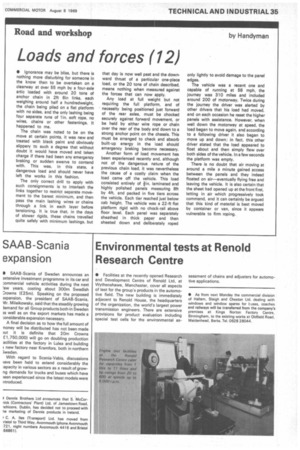Loads and forces (12)
Page 37

If you've noticed an error in this article please click here to report it so we can fix it.
• Ignorance may be bliss, but there is nothing more disturbing for someone in the know than to be overtaken on a clearway at over 55 mph by a four-axle at-tic loaded with around 20 tons of anchor chain in 2ft 6in links, each weighing around half a hundredweight, the chain being piled on a flat platform with no sides, and the only lashing being four separate runs of 1in. soft rope, no wires, chains or other fastenings. It happened to me.
The chain was noted to be on the move at certain points, it was new and treated with black paint and obviously slippery to such a degree that without doubt it would have moved and taken charge if there had been any emergency braking or sudden swerve to contend with. This was, in this state, a dangerous load and should never have left the works in this fashion.
The only correct drill to apply with such consignments is to interlash the links together to restrict separate movement to the barest minimum, and then pass the main lashing wires or chains through a link in each layer before tensioning. It is true that, in the days of slower rigids, these chains travelled quite safely with minimum lashings, but that day is now well past and the downward thrust of a particular one-piece load, or the 20 tons of chain described, means nothing when measured against the forces that can now apply.
Any load at full weight but not requiring the full platform, and of necessity being positioned just forward of the rear axles, must be chocked securely against forward movement, or be held by either wire rope or chain over the rear of the body and down to a strong anchor point on the chassis. This must be arranged to check and absorb built-up energy in the load should emergency braking become necessary.
Another form of load movement has been experienced recently and, although not of the dangerous nature of the previous chain load, it was nevertheless the cause of a costly claim when the load came off the vehicle. This load consisted entirely of fin. laminated and highly polished panels measuring 8ft by 4ft, and packed in five tiers across the vehicle. Each tier reached just below cab height. The vehicle was a 22-ft flat platform rigid with no chock-rail above floor level. Each panel was separately sheathed in thick paper and then sheeted down and deliberately roped only lightly to avoid damage to the panel edges.
The vehicle was a recent one and capable of running at 58 mph, the journey was 310 miles and included around 200 of motorway. Twice during the journey the driver was alerted by other drivers that his load had moved, and on each occasion he reset the higher panels with assistance. However, when well down the motorway at speed, the load began to move again, and according to a following driver it also began to move up and down: in fact, this other driver stated that the load appeared to float about and then simply flew over both sides of the vehicle. In a few seconds the platform was empty.
There is no doubt that air moving at around a mile a minute gained access between the panels and they indeed floated on air—eventually flying free and leaving the vehicle. It is also certain that the sheet had opened up at the front first, letting in air which progressively took command, and it can certainly be argued that this kind of material is best moved by container or van, since it appears vulnerable to firm roping.




































































































